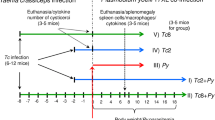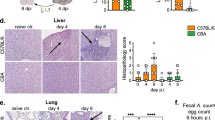Abstract
Pneumonia is the leading killer of children worldwide. Here, we report that helminth-infected mice develop fatal pneumonia when challenged with Streptococcus pneumoniae. Mice were chronically infected with either the flatworm Taenia crassiceps or the roundworm Heligmosomoides polygyrus. Upon challenge with a pneumonic type 3 strain of S. pneumoniae (A66.1), the worm-infected mice developed pneumonia at a rate and to a degree higher than age-matched control mice as measured by bioluminescent imaging and lung titers. This predisposition to pneumonia appears to be specific to S. pneumoniae, as worm-infected mice did not show evidence of increased morbidity when challenged with a lethal dose of influenza virus or sublethal doses of Staphylococcus aureus or Listeria monocytogenes. The defect was also present when worm-infected mice were challenged with a type 2 sepsis-causing strain (D39); an increased rate of pneumonia, decreased survival, and increased lung and blood titers were found. Pneumococcal colonization and immunity against acute otitis media were unaffected. Anti-helminthic treatment in the H. polygyrus model reversed this susceptibility. We conclude that helminth coinfection predisposes mice to fatal pneumococcal pneumonia by promoting increased outgrowth of bacteria in the lungs and blood. These data have broad implications for the prevention and treatment for pneumonia in the develo** world, where helminth infections are endemic and pneumococcal pneumonia is common.





Similar content being viewed by others
References
Black RE, Cousens S, Johnson HL, Lawn JE, Rudan I, Bassani DG, Jha P, Campbell H, Walker CF, Cibulskis R, Eisele T, Liu L, Mathers C (2010) Global, regional, and national causes of child mortality in 2008: a systematic analysis. Lancet 375:1969–1987
Dagan R, Bhutta ZA, de Quadros CA, Garau J, Klugman KP, Khuri-Bulos N, Levine O, Saha SK, Sow S, Were F, Yang Y (2011) The remaining challenge of pneumonia: the leading killer of children. Pediatr Infect Dis J 30:1–2
Bundy D, Sher A, Michael E (2000) Good worms or bad worms: do worm infections affect the epidemiological patterns of other diseases? Parasitol Today 16:273–274
Modjarrad K, Vermund SH (2010) Effect of treating co-infections on HIV-1 viral load: a systematic review. Lancet Infect Dis 10:455–463
Wammes LJ, Hamid F, Wiria AE, de Gier B, Sartono E, Maizels RM, Luty AJ, Fillie Y, Brice GT, Supali T, Smits HH, Yazdanbakhsh M (2010) Regulatory T cells in human geohelminth infection suppress immune responses to BCG and Plasmodium falciparum. Eur J Immunol 40:437–442
Minino AM, Heron MP, Murphy SL, Kochanek KD (2007) Deaths: final data for 2004. Natl Vital Stat Rep 55:1–119
Hotez PJ (2008) Neglected infections of poverty in the United States of America. PLoS Negl Trop Dis 2:e256
Burton DC, Flannery B, Bennett NM, Farley MM, Gershman K, Harrison LH, Lynfield R, Petit S, Reingold AL, Schaffner W, Thomas A, Plikaytis BD, Rose CE Jr, Whitney CG, Schuchat A (2010) Socioeconomic and racial/ethnic disparities in the incidence of bacteremic pneumonia among US adults. Am J Public Health 100:1904–1911
Spolski RJ, Corson J, Thomas PG, Kuhn RE (2000) Parasite-secreted products regulate the host response to larval Taenia crassiceps. Parasite Immunol 22:297–305
Finney CA, Taylor MD, Wilson MS, Maizels RM (2007) Expansion and activation of CD4(+)CD25(+) regulatory T cells in Heligmosomoides polygyrus infection. Eur J Immunol 37:1874–1886
Smith MW, Schmidt JE, Rehg JE, Orihuela C, McCullers JA (2007) Induction of pro- and anti-inflammatory molecules in a mouse model of pneumococcal pneumonia following influenza. Comp Med 57:82–89
McCullers JA, Karlstrom A, Iverson AR, Loeffler JM, Fischetti VA (2007) Novel strategy to prevent otitis media caused by colonizing Streptococcus pneumoniae. PLoS Pathog 3:e28
McCullers JA, Bartmess KC (2003) Role of neuraminidase in lethal synergism between influenza virus and Streptococcus pneumoniae. J Infect Dis 187:1000–1009
McCullers JA (2004) Effect of antiviral treatment on the outcome of secondary bacterial pneumonia after influenza. J Infect Dis 190:519–526
McCullers JA, McAuley JL, Browall S, Iverson AR, Boyd KL, Henriques NB (2010) Influenza enhances susceptibility to natural acquisition of and disease due to Streptococcus pneumoniae in ferrets. J Infect Dis 202:1287–1295
Kofoid CA, Tucker JP (1921) On the relationship of infection by hookworm to the incidence of morbidity and mortality in 22,842 men of the United States army at Camp Bowie, Texas, from October 1917 to April 1918. Am J Epidemiol 1:79–117
Borkow G, Bentwich Z (2004) Chronic immune activation associated with chronic helminthic and human immunodeficiency virus infections: role of hyporesponsiveness and anergy. Clin Microbiol Rev 17:1012–1030
Borkow G, Leng Q, Weisman Z, Stein M, Galai N, Kalinkovich A, Bentwich Z (2000) Chronic immune activation associated with intestinal helminth infections results in impaired signal transduction and anergy. J Clin Invest 106:1053–1060
Loukas A, Prociv P (2001) Immune responses in hookworm infections. Clin Microbiol Rev 14:689–703
Doetze A, Satoguina J, Burchard G, Rau T, Loliger C, Fleischer B, Hoerauf A (2000) Antigen-specific cellular hyporesponsiveness in a chronic human helminth infection is mediated by T(h)3/T(r)1-type cytokines IL-10 and transforming growth factor-beta but not by a T(h)1 to T(h)2 shift. Int Immunol 12:623–630
Jackson JA, Turner JD, Kamal M, Wright V, Bickle Q, Else KJ, Ramsan M, Bradley JE (2006) Gastrointestinal nematode infection is associated with variation in innate immune responsiveness. Microbes Infect 8:487–492
Urban JF Jr, Madden KB, Svetic A, Cheever A, Trotta PP, Gause WC, Katona IM, Finkelman FD (1992) The importance of Th2 cytokines in protective immunity to nematodes. Immunol Rev 127:205–220
Potian JA, Rafi W, Bhatt K, McBride A, Gause WC, Salgame P (2011) Preexisting helminth infection induces inhibition of innate pulmonary anti-tuberculosis defense by engaging the IL-4 receptor pathway. J Exp Med 208:1863–1874
Chen F, Liu Z, Wu W, Rozo C, Bowdridge S, Millman A, van Nico R, Urban JF Jr, Wynn TA, Gause WC (2012) An essential role for TH2-type responses in limiting acute tissue damage during experimental helminth infection. Nat Med 18:260–266
Toenjes SA, Spolski RJ, Mooney KA, Kuhn RE (1999) The systemic immune response of BALB/c mice infected with larval Taenia crassiceps is a mixed Th1/Th2-type response. Parasitology 118:623–633
Moreira LO, El Kasmi KC, Smith AM, Finkelstein D, Fillon S, Kim YG, Nunez G, Tuomanen E, Murray PJ (2008) The TLR2-MyD88-NOD2-RIPK2 signalling axis regulates a balanced pro-inflammatory and IL-10-mediated anti-inflammatory cytokine response to gram-positive cell walls. Cell Microbiol 10:2067–2077
Andrade EB, Alves J, Madureira P, Oliveira L, Ribeiro A, Cordeiro-da-Silva A, Correia-Neves M, Trieu-Cuot P, Ferreira P (2013) TLR2-induced IL-10 production impairs neutrophil recruitment to infected tissues during neonatal bacterial sepsis. J Immunol 191:4759–4768
du Plessis N, Kleynhans L, Thiart L, van Helden PD, Brombacher F, Horsnell WG, Walzl G (2013) Acute helminth infection enhances early macrophage mediated control of mycobacterial infection. Mucosal Immunol 6:931–941
Sutherland RE, Xu X, Kim SS, Seeley EJ, Caughey GH, Wolters PJ (2011) Parasitic infection improves survival from septic peritonitis by enhancing mast cell responses to bacteria in mice. PLoS One 6:e27564
World Health Organization (2005) The World Health Report 2005—make every mother and child count. pp 1–243. http://www.who.int/whr/2005/whr2005_en.pdf
Cooper PJ, Chico ME, Losonsky G, Sandoval C, Espinel I, Sridhara R, Aguilar M, Guevara A, Guderian RH, Levine MM, Griffin GE, Nutman TB (2000) Albendazole treatment of children with ascariasis enhances the vibriocidal antibody response to the live attenuated oral cholera vaccine CVD 103-HgR. J Infect Dis 182:1199–1206
Acknowledgments
This work was supported by the American Lebanese Syrian Associated Charities (ALSAC). All authors declare that no conflict of interest exists. We would like to thank Dr. Maureen McGargill for provision of Listeria and helpful discussions on its use, and Ms. Amy Iverson and Melissa Morris for technical assistance.
Author information
Authors and Affiliations
Corresponding author
Rights and permissions
About this article
Cite this article
Apiwattanakul, N., Thomas, P.G., Kuhn, R.E. et al. Helminth infections predispose mice to pneumococcal pneumonia but not to other pneumonic pathogens. Med Microbiol Immunol 203, 357–364 (2014). https://doi.org/10.1007/s00430-014-0344-3
Received:
Accepted:
Published:
Issue Date:
DOI: https://doi.org/10.1007/s00430-014-0344-3




